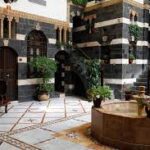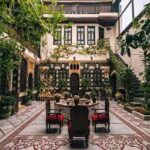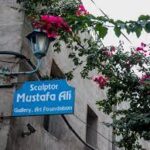While taking a walk in Old Damascus alleys, you will notice a transformation not in the scenery site but in place utilization and occupation; most of old Damascene houses are no longer used for residential purposes- houses which were once inhabited by renowned Damascene families.Some of those historic edifices have been renovated into restaurants, keeping the Damascene architectural character and some even serving Syrian traditional dishes. However, is it possible to make other new usage of such buildings in the vibrant city centre of Damascus?
Many cities and countryside are home to old, abandoned buildings—from warehouses to lighthouses. Damascus as one of the oldest capitals in the world is no exception; with its rich architectural heritage descendant from succeeding civilizations. The observer will distinguish various old buildings such as palaces like Alzem Palace, khans such as Khan Asaad Basha, public baths as Hammam Bakry, ancient schools like Dar Elhekma, to name few but as well old granaries, Roman temples, monasteries, Ottoman and French edifices going back to the colonial era.
Reusing old Damascene houses in the hospitality industry was a very creative idea.Since those houses are self-centred buildings with vast courtyards mediating the building, surrounded by halls on the ground floor and bedrooms on the first floor.
An architectural structure by its preliminary scheme mirroring hotels, inns and pensions structures where communal activities, like catering, meeting and mingling could be accomplished in the central courtyard that resembles hotel halls. Whereas,adjacent big rooms called “Haramlek” “Salamlek” “Diwania” could be used as game enclaves, gyms, libraries, or spas.First floor rooms could be used as hotel rooms a good example is Beit El Wali boutique hotel in the old city centre
This hotel is a collection of 3 ordinary Damascene houses of the 18th century, which were renovated in 2007 to present Syrian culture and tradition in a modern luxurious and spectacular design. The distinguished style of the 18th century is captured in the hotel’s hand-crafted wooden ceilings.The oriental architecture is highlighted in various spaces leading to an awesome scenery from the past.
Only few experiences have escaped the typical reuse of old Damascene houses in hospitality industry, and tried to be more innovative by taking the initiative of altering their primary purpose as residential places to art galleries ateliers of renowned Syrian artists or sculptors like Dar Moustafa Alior Dar Abdallah that have “recycled”Damascene houses into galleries exposing artworks. However,inflation high rates, forced owners of those houses _who are by their majority artists, and are no more capable of preserving those historical edifices_to create new usages for their properties, like altering those art galleries into cultural houses hosting cultural activities, or transforming them into small playhouses for musical and theatrical performances for an elitist audience, since the place could only accommodate up to fifty persons.
Adapting new strategies of space reuse have always been an endeavour of householders, architects, companies, city planners, and governments.Since life and lifestyles are in a perpetual change, and we are in a constant need to acclimatise space to accommodate our new lives requirements, we are constantly in need of new plans to make the best of our space.
Moreover, in a progressive world demanding new adaptations of places to follow up new technologies, we have to show our creative and innovative side to catch up with modern lifestyle. Therefore, managing space occupancy is no more the preoccupation of big corporations, but anyone having a space.
A rising architecture approach called “adaptive reuse” offers a way to breathe new life into empty historic structures.Adaptive reuse preserves historic places and transforms vacant buildings into new homes, offices, and hotels while making financial and sustainable sense.
In architecture, adaptive reuse (also called building reuse) refers to the repurposing of an existing structure for new use. For example, converting an old church into a restaurant, an old train station into an office space, or an old windmill into a home. Adaptive reuse architecture breathes new life into historic structures by converting them into something useful for the surrounding.
Would adaptive-reuse approach be on the table as a national project in the next years in Syria as we are witnessing suggestions in regard to rebuilding strategies. War aftermath in Syria has had tremendous implications on infrastructure and real estate sectors, since most damages’ have affected those two sectors. Furthermore, most war’s waste is made of building materials remnants like cemented fragments or iron bars. So being able to transform those remnants into recycled building materials would be a great achievement.But what about recycling old historical buildings ?Is it plausible to recycle whole buildings?
The answer lies in a famous saying by architect and sustainability expert Carl Elefante: “The greenest building is the one that is already built.”. Moreover, experts predict that 90% of real-estate development in the next decade will focus on renovating and reusing existing structures. It is easy to see why: Adaptive-reuse projects are generally faster, more cost-effective, and more sustainable to construct than new buildings.
Report: Lama Alhassanieh




